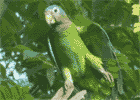 |
CATADUPA CONSERVATION ACTION PLAN |
 |
Expert Workshop Attendees (click here)
LIST of BIOLOGICAL TARGETS:
1. Wet Limestone Forest
2. Cave Communities
3. Karst Freshwater Ecosystems
4. Amphibians
5. Giant Swallowtail Butterfly
6. Plain Pigeon
Notes
:1Mulgrave
community members report that orchid and wythes ["wiss"] collecting no longer occurs in southern Catadupa.
2Jamaican Blackbird (local name = Wild Pine Sergeant) depends upon healthy tank bromeliads for foraging. It is also highly vulnerable to brood-parasitism by the Shiny Cowbird. Maintenance of forest connectivity / preventing fragmentation and creation of edge habitat should provide adequate protection for the Jamaican Blackbird.
3Mulgrave community members report that parrot poaching is not a problem in southern Catadupa.
4Mulgrave community members note that Jamaican Boas have always been rare in southern Catadupa (NB, elevation may be too high for the thermal range of this species); however poaching does occur in Maroon Town, but the extent and effects on the population remain unknown. The species may require elevation to ÒTargetÓ if poaching is determined to be a threat.
|
Target #2 |
Criteria /
Rationale |
Nested Targets |
Attributes / Functions |
Processes which
maintain the target |
|
2.
Cave communities Biodiversity Level: Community Spatial Scale: Micro-site discrete caves Note: There are at least 45 caves & sinkholes listed in Jamaica Underground for Catadupa |
á Bats are critical species for pollination, seed dispersal and insect consumption á Highly specialized cave-adapted fauna; many invertebrates are endemic á Species highly vulnerable to disturbance and degradation because of typically-small population sizes and patchy distributions within a cave á Low resilience to disturbance and changes in cave microclimate conditions |
á Cave-dependent bats: (a) daytime year-round roost; (b) seasonal maternity roosts á Guano-dependent invertebrates á Other cave invertebrates (e.g., detritivores) á Amphibians, esp. Eleutherodactylus cundalli |
á Geologic substrate and associated fault, fracture, and dissolution patterns á Cave size and associated diversity of microhabitats (e.g. level of darkness, temperature, relative humidity, airflow & CO2- O2 concentrations) á Cave isolation (particularly important for evolutionary divergence and evolution of endemic species á Critical daytime and maternity roosts for cave-dependent bat species á Connectivity to terrestrial forest == non-substitutable component critical to maintaining a functional karst landscape |
á Stability of microclimate á Natural disturbance regimes (generally very low level) á Vegetative nutrient inputs á Guano nutrient inputs á Patterns of energy inputs (high vs. low; pulse vs. steady) á Species composition and dominance (e.g. distribution of bats has direct influence on distribution of guano-dependent invertebrates in a cave) á Bat access to food resources: (a) forest connectivity at cave opening / forest interface; (b) forest connectivity across the landscape for nightly and seasonal movements of Òcluttered-spaceÓ forest-dependent echolocators á Natural predator-prey dynamics á Natural mortality rates á Absence of invasive alien species |
|
Target #3 |
Criteria /
Rationale |
Nested Targets |
Attributes /
Functions |
Processes which
maintain the target |
|
3.
Karst freshwater ecosystems Biodiversity Level: Ecological system Spatial Scale: Regional – connected via vadose and phreatic components of the aquifer NOTE: need to consult with WRA and other experts, such as Christoph Schubart ref crustaceans and Kimberly John ref YS River surveys |
á Terrestrial components include the Niagara River and upper reaches of the YS River á Recharge area for freshwater supply of western Jamaica, including the Great River, Montego River, and Black River, the latter of which is designated as a ÒTriple Priority OverlapÓ of terrestrial, freshwater, and marine ecosystems in the National Ecological Gap Assessment Report (2009). á Highly specialized ecosystems with endemic species á High level of threat because of pollution (incl. inappropriate solid waste disposal in sinkholes), pesticides, sedimentation, and nutrient enrichment |
á Subterranean aquatic biota (stygobites and stygophiles) – mostly invertebrates á Above-ground spring and river freshwater communities, which depend upon the quantity and quality of water filtered through the Catadupa aquifer; this will include diadromous species, such as Macrobrachium shrimp and Anguilla eels, which migrate between the sea and freshwater ecosystems á
Floral and faunal communities of the riparian
zone (ref Niagara River and upper reaches of the YS River) |
á Habitat for freshwater organisms á Water regulation: retention, flow rates (incl. seasonal patterns and pulse flooding events) and storage á Water purification: clean, filtered water for human extraction á Water purification: clean, filtered water all the way down to marine ecosystems |
á Connectivity between terrestrial and subterranean components of the karst aquifer, particularly the associated permeability of the substrate á Hydrologic regime á Water chemistry á Characteristic allochthonous inputs á In-stream longitudinal migration á Sediment erosion / deposition regime á Species composition, richness, and trophic diversity á Absence of invasive alien species |
|
Target #4 |
Criteria /
Rationale |
Nested Targets |
Attributes /
Functions |
Processes which
maintain the target |
|
4.
Amphibians Biodiversity Level: Guild Spatial Scale: Catadupa |
á Extraordinary levels of endemism, which contribute to the high global ranking of the ÒCaribbean Biodiversity HotspotÓ á Chytrid fungus already confirmed present in Jamaica; protecting the wet limestone forest will not guarantee protection of frogs because of this lethal fungus. |
á All Eleutherodactylus species, which undergo direct development within the egg á All Hylidae frogs, which have a free-swimming tadpole stage á
Tank bromeliad communities |
á Genetic diversity: Catadupa frog populations include island-endemic species and species restricted to the Cockpit Country plateau á Predators of aquatic insect larvae, such as mosquitoes á Prey resource for other species |
á Absence of chytrid fungus á Resistance or resilience to chytrid fungus á Climatic gradient: temperature, relative humidity, sunlight (particularly UV light) á Forest physiognomy: structural diversity from forest floor to canopy enabled adaptive radiation of frogs and maintains species richness á Topography-mediated microclimates, from bottomlands, talus slopes, and hilltops. á Habitat connectivity, notably forest-cave interface for Eleutherodactylus cundalli, which has unique maternal care á Predator / prey dynamics á Intra- and interspecific competition for breeding sites á Juvenile dispersal |
|
Target #5 |
Criteria /
Rationale |
Nested Targets |
Attributes /
Functions |
Processes which
maintain the target |
|
5.
Giant Swallowtail Biodiversity Level: Species Spatial Scale: National |
á Endemic to Jamaica á Largest butterfly in the New World á Listed by IUCN as Endangered á Very specific microhabitat and larval food plant requirements may not be addressed by protecting the wet limestone forest á Historically ( up to 1970s) occurred in Mulgrave but no longer seen there; cause of decline unknown but likely associated with conversion of habitat and isolation of forest patches :: potential to restore into its historic range and increase population size |
á Other forest-dependent endemic butterflies, notably Grais juncta (currently known only from Catadupa) and Atlantea pantoni (Catadupa is the second largest of 3 small breeding sites in Jamaica), and Protographium marcellinus (Cockpit Country plateau is a stronghold) |
á Cultural icon, both for Jamaica and the Western Hemisphere á Pollinator (because of its size, compared to all other diurnal butterfly species, it may be a sole legitimate pollinator of some plants) |
á Microclimate: very high relative humidity á Microclimate: temperature-related sex determination á Presence of larval food plant á Presence of adult food plants á Presence of natural forest gaps for male territories á Forest connectivity (travel corridors) to enable females to find multiple male territories á Natural rates of predation and parasitism á Population size to maintain genetic variability á Maintenance (or re-establishment) of corridor between core Cockpit Country and Catadupa to ensure historic patterns of gene flow. á Absence of poaching |
|
Target #6 |
Criteria /
Rationale |
Nested Targets |
Attributes /
Functions |
Processes which
maintain the target |
|
6.
Plain Pigeon Biodiversity Level: Species Spatial Scale: National |
á Seasonal migration: habitat usage extends outside of Catadupa so there is a need to identify movement corridors and usage of coastal ecosystems to ensure full habitat protection á Hunted illegally; hunters claim they might misidentify it in-flight during bird shooting season á Global range restricted to the Greater Antilles. Once considered abundant and widespread, it has undergone considerable declines across all islands. In Jamaica it has been considered scarce since as early as 1840 and is now considered rare and local1 |
á
Other forest-dependent Columbidae,
including White-crowned Pigeons which also make seasonal migrations between
breeding and non-breeding habitats |
á Seed dispersal á Large-body prey for native and endemic predators |
á Natural rates of reproduction and survival á Age structure of the population á Seasonal migration á Availability of micro-minerals á Seasonal food availability á Forest size: large enough area to support viable breeding population á Habitat connectivity á Absence of pathogens and parasites associated with e.g., poultry or birds in the pet trade |
1IUCN Red List, accessed 9 October 2013. <http://www.iucnredlist.org/details/106002487/0>